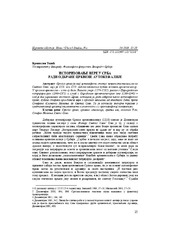Приказ основних података о документу
Istorizovanje vere u Srba radi odbrane crkvene autokefalije
Historicizing the orthodox faith in defence of Serbian autocephaly
| dc.creator | Todić, Branislav | |
| dc.date.accessioned | 2021-10-12T12:55:25Z | |
| dc.date.available | 2021-10-12T12:55:25Z | |
| dc.date.issued | 2019 | |
| dc.identifier.issn | 1820-2446 | |
| dc.identifier.uri | http://reff.f.bg.ac.rs/handle/123456789/2741 | |
| dc.description.abstract | Srpska crkva je svoj autokefalni status neprekidno temeljila na Svetom Savi, koji je 1218. ili 1219. godine kanonskim putem osnovao Arhiepiskopiju. U kriznim vremenima - a to su bili Lionska unija (1274-1282), raskol s Carigradskom patrijaršijom (1346-1375) i sukob s Ohridskom arhiepiskopijom (oko 1530-1540) - kad je bio ugrožavan opstanak Crkve, isticana je, radi odbrane njenih autokefalnih prava, duboka starina hrišćanske vere u srpskim zemljama, od apostola Tita, preko Stefana (Simeona) Nemanje, do Svetog Save. To je ostavilo značajne tragove u srednjovekovnoj crkvenoj književnosti i umetnosti i u hronografskoj literaturi. | SR |
| dc.description.abstract | The Serbian Church based its autocephalous status on St Sava of Serbia who had canonically established it as an archbishopric in 1218 or 1219. It had never officially claimed apostolic origin, because it did not have one, referring to it only in the general sense - and thus sharing the position of the entire Orthodox Church - of the apostles being the foundation of the church of Christ. In times of crisis, however - and those were the Union of Lyon (1274-1283), the split with the Ecumenical Patriarchate (1346-1375) and, as it seems, a conflict with the Archbishopric of Ohrid (c. 1530-1540) - when its autocephalous status was at stake, the Serbian Church resorted to the apostolic argument in defence of its rights. A legend of the first spreading of Christ's teachings in the Serbian lands by the apostles traced it to Paul's disciple Titus, since it was known from the Second Epistle to Timothy (4:10) that he had preached in Dalmatia, which was an integral part of the medieval Serbian state. In the historicization of the faith an important place in creating the Serbian Archbishopric was accorded to Grand Župan Stefan Nemanja (St Symeon), who had restored and consolidated the Orthodox faith in his realm. The work of the apostle Titus and Stefan Nemanja was completed by Nemanja's son Sava, who became the first archbishop of the Serbian Church and canonically brought his people into the Orthodox communion. Of limited duration and never officially accepted, the legend nonetheless left a trace in Serbian religious literature and art and chronographic texts, but it never downplayed, nor did it intend to, the role and importance of St Sava in the creation and history of the Serbian Archbishopric. | EN |
| dc.publisher | Centar za crkvene studije, Niš | |
| dc.rights | openAccess | |
| dc.source | Crkvene studije | |
| dc.subject | Sveti Sava | SR |
| dc.subject | Stefan Nemanja | SR |
| dc.subject | Srpska crkva | SR |
| dc.subject | srednji vek | SR |
| dc.subject | crkvena ideologija | SR |
| dc.subject | apostol Tit | SR |
| dc.title | Istorizovanje vere u Srba radi odbrane crkvene autokefalije | SR |
| dc.title | Historicizing the orthodox faith in defence of Serbian autocephaly | EN |
| dc.type | article | |
| dc.rights.license | ARR | |
| dc.citation.epage | 28 | |
| dc.citation.issue | 16-2 | |
| dc.citation.other | 16(16-2): 15-28 | |
| dc.citation.rank | M51 | |
| dc.citation.spage | 15 | |
| dc.citation.volume | 16 | |
| dc.identifier.fulltext | http://reff.f.bg.ac.rs/bitstream/id/1422/2738.pdf | |
| dc.identifier.rcub | https://hdl.handle.net/21.15107/rcub_reff_2741 | |
| dc.type.version | publishedVersion |

